
The Osprey class was a Royal Navy class of screw-driven sloops built between 1874 and 1877. Nine additional ships were built to a revised design, the Doterel-class sloop. They were the first class of ship in the Royal Navy to use glass scuttles.

The Algerine-class gunboats were a class of six 3-gun wooden gunboats built for the Royal Navy in 1857. A further pair were built in India for the Bombay Marine in 1859.

The Mariner class was a class of six 8-gun gunvessels built for the Royal Navy between 1883 and 1888. Four were built in the Naval Dockard at Devonport, and two elsewhere; the Acorn was built by contract at Jacobs Pill on the Pembroke River, while the Melita was built in the Malta Dockyard, the only substantial ship of the Royal Navy ever to be built in the island.
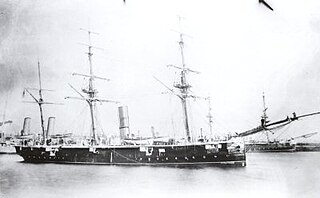
The Satellite class was a class of 12-gun composite sloops built for the Royal Navy between 1883 and 1888, and reclassified as corvettes in 1884.

The Redbreast class comprised nine first-class screw-driven composite gunboats built for the Royal Navy in 1889, mounting six guns.

HMS Wasp was a Banterer-class composite screw gunboat of the Royal Navy, built in 1880 by Barrow Iron Shipbuilding and wrecked off Tory Island in 1884.
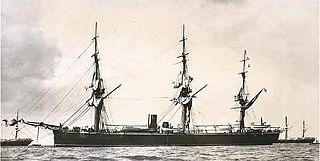
HMS Rover was an 18-gun iron screw corvette built for the Royal Navy in the 1870s, the sole ship of her class. The ship was initially assigned to the North America and West Indies Station until she returned home in 1879. She was transferred to the Training Squadron when it formed in 1885. Rover was not really suitable for such a role and she was placed in reserve four years later and then sold for scrap in 1893.

HMS Hyacinth was an 8-gun Satellite-class composite sloop built for the Royal Navy, launched in 1881 and sold in 1902. She and the rest of her class were re-classified as corvettes in 1884.
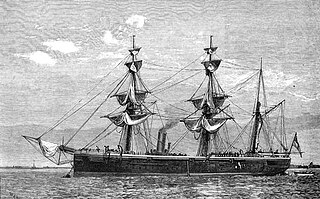
The Doterel class was a Royal Navy class of screw-driven sloops. They were of composite construction, with wooden hulls over an iron frame. They were a revised version of an 1874 design by the Royal Navy's Chief Constructor, William Henry White, the Osprey-class sloop. Two of the class were lost, one to an explosion off Chile and one wrecked off Canada. Gannet is preserved at Chatham Historic Dockyard.

HMS Raven was a Banterer-class gunboat of the Royal Navy, built by Samuda Brothers of Poplar, London, and launched on 18 May 1882. She served on the Australia Station and was converted to a diving tender in 1904. After being lent as a training ship in 1913 she was sold for breaking in 1925.

The Ariel-class gunboat was a class of nine 4-gun composite gunboats built for the Royal Navy between 1871 and 1873. Although most were sold by 1890, one of them survived into the 1920s as a salvage vessel in private ownership. They were the first class of Royal Navy gunboat built of composite construction, that is, with iron keel, stem and stern posts, and iron framing, but planked with wood.
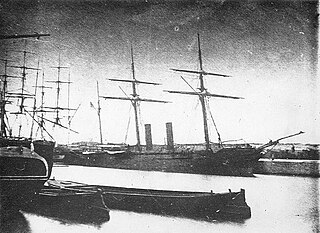
Intrepid-class gunvessels were a class of six Royal Navy first-class wooden gunvessels built in 1855-56. They were rated as sloops from 1859 to 1862, and were scrapped by 1865. Victor was sold to the Confederate States of America as the raider CSS Rappahannock, but she was interned by the French at Calais and never fulfilled her intended function.

HMS Trent was a Medina-class gunboat launched in 1877. She was the fifth ship of the Royal Navy to be named after the River Trent. She was renamed HMS Pembroke in 1905, and served off the coast of Tanganyika in 1915. She was renamed HMS Gannet in 1917 while serving as a diving tender. She was scrapped in 1923.
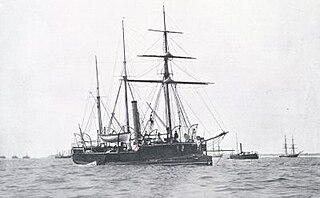
The Medina-class gunboat was a class of 12 Royal Navy Rendel gunboats mounting three 6.3-inch guns, built between 1876 and 1877. Flat-iron gunboats were normally built without masts or rigging, but the Medinas carried a full barquentine rig. Their robust iron hulls meant that they lingered on as diving tenders, barges and lighters, with five of them working into the 1920s. The hull of Medway lies in shallow water in Bermuda and is visible on satellite imagery.

HMS Mutine was a Doterel-class sloop of the Royal Navy, built at the Devonport Dockyard and launched on 20 July 1880. She became a boom defence vessel at Southampton in 1899 and was renamed Azov in 1904. She was sold after World War I.

The Emerald-class corvettes were a class of six composite screw corvettes built for the Royal Navy in the mid-1870s. The Opal was built by contract under the 1873-74 Programme, and Turquoise, Ruby, Tourmaline and Emerald under the 1874-75 Programme - the first three also by contract, while Emerald was dockyard-built at Pembroke. The final ship (Garnet) was also dockyard-built at Chatham under the 1875-76 Programme.

The Banterer-class gunboat was a class of eleven gunboats mounting two 6-inch and two 4-inch guns, built for the Royal Navy between 1880 and 1892.

The Albacore-class gunboat, also known as "Crimean gunboat", was a class of 98 gunboats built for the Royal Navy in 1855 and 1856 for use in the 1853-1856 Crimean War. The design of the class, by W. H. Walker, was approved on 18 April 1855. The first vessels were ordered the same day, and 48 were on order by July; a second batch, which included Surly, were ordered in early October.

The Forester-class gunboat was a class of 4-gun composite gunboats built for the Royal Navy between 1874 and 1877. Although half had been sold by 1890, the rest survived into the 20th century as coal hulks, base vessels and other secondary uses. Foxhound survived as a hulk on the Blackwall Reach of the Thames until 1975, when she was broken up. They were built of composite construction, that is, with iron keel, stem and stern posts, and iron framing, but planked with wood.

The Driver class were a class of paddlewheel steam sloops of the British Royal Navy. Six Driver-class ships were ordered in 1840 and a further ten in March 1841, although only six were built. Five were ordered in 1847, but all were either built as paddle frigates or cancelled. Two wrecked in service, while the rest served until being retired and were either broken up or sold.



















